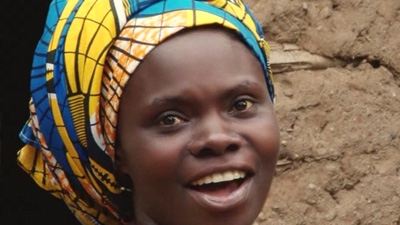Like Jeanne, Cecile 25, who started sex work at the age of 13, was able to give up sex work and start a palm oil business using a grant from the same project.
“With 2000 Burundi francs ($1.50), I’m able to pay my daily food ration,”says Cecile, who is HIV-negative and glad that she no longer has to go from pub to pub in search of clients.
Preventing the spread of HIV, especially among vulnerable groups
Through the project, which covered all of Burundi’s 17 provinces, Jeanne, Bella, Cecile, and over 14,000 other female sex workers in the country have learned more about HIV and other infections.
“We have been sensitized by watching movies showing that HIV/AIDS kills and we were given condoms to protect ourselves against sexually transmitted infections,”Jeanne says.
As a result of this outreach and support from other donors, condom use among female sex workers covered by this project—which specifically targets vulnerable groups—has gone up by 10 percentage points, from 82 percent in 2008 to nearly 92 percent in June 2011.
More broadly, preliminary data from the 2010 Demographic and Health Survey for Burundi estimate that 14 percent of men aged 15-49 who have had more than one sexual partner in the past 12 months reported using a condom, up from 6 percent reported by the 2007 Behavioral Surveillance Survey.
Besides vulnerable groups, the project also targeted people living with HIV/AIDS and affected individuals and families; and pregnant women and their babies. It has helped to raise the share of HIV-affected pregnant women treated with antiretroviral (ARV) drugs from 15 percent in 2008 to 41 percent in June 2011. ARVs reduce the risk of mother-to-child transmission of HIV.
These are notable results, as there were about 180,000 people living with HIV in Burundi in 2009 (UNAIDS, 2009). As part of its National Health Strategy, the government has been trying to check the spread of sexually transmitted infections and improve the quality of life of those living with HIV.
The project, along with significant support from other donors, has contributed to Burundi’s declining HIV prevalence rate among the general population from an estimated three percent in 2007 to 1.4 percent in 2010.
Results-Based Financing in Burundi
Behind the scenes, an approach known as “results-based financing” has recently helped to ramp up the national HIV/AIDS response. Here, frontline health facilities are paid based on delivery of a pre-agreed set of health services, such as the number of HIV detections.
Following well-documented results in Rwanda—where the results-based financing of frontline health facilities partly contributed to dramatic improvements in some health indicators—Burundi is seeing early success as well, with technical assistance from the World Bank.
Since Burundi scaled up results-based financing and included several HIV/AIDS indicators in the scheme, there have been sharp increases in the number of people seeking voluntary testing and counseling, the number of persons newly put on ARV, the number of HIV positive pregnant mothers under treatment to prevent transmission to their babies, and more.`
Changes in clinical HIV indicators in Burundi (2005 – 2011)
VCT = Voluntary Counseling and Testing; ARV = Anti-retrovirals; PMTCT = Pregnant Mother to Child Transmission; MC = Male circumcision. All indicators in 10s except VCT (1000s)
"World Bank support in mitigating HIV/AIDS amongst vulnerable groups has been transformative,” said Mercy M. Tembon, World Bank Acting Country Director for Burundi, Uganda and Tanzania, and Country Manager for Burundi. “The strong results registered clearly demonstrate how our support has made a difference and improved the lives of the young women involved in the sex trade. This effort has also contributed to the achievement of the Millennium Development Goals on gender equality and empowerment of women, as well as on combating diseases such as HIV/AIDS."

